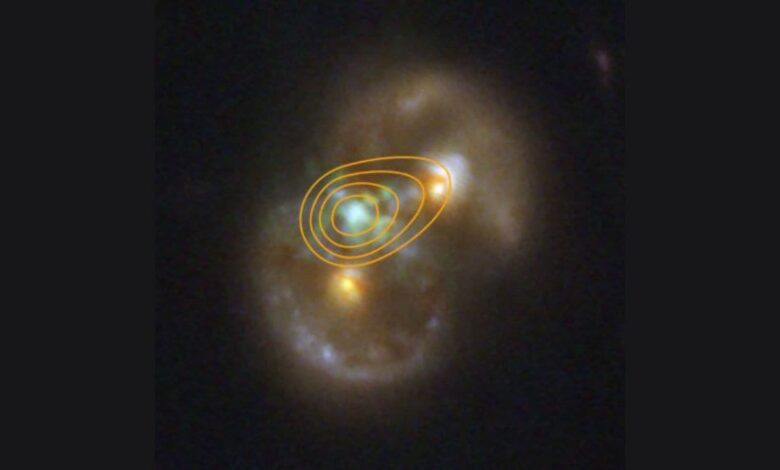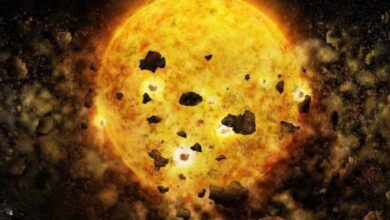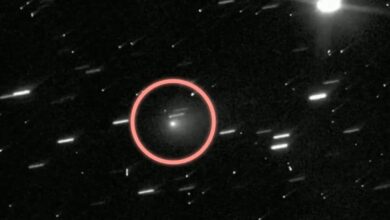JWST Discovers Rare Black Hole Birth Between Galaxies

Rare Black Hole Discovery: A Cosmic Anomaly
Astronomers have made a groundbreaking discovery – a peculiar black hole nestled between colliding galaxies. This unusual object is causing its galactic host to wobble, suggesting it’s undergoing a rare “direct collapse” in the universe’s infancy. What makes this black hole truly unique is its location: it resides between a pair of merging galaxies, rather than at the nucleus of either one. This odd placement indicates that the black hole may have formed from a collapsing cloud of gas and dust, a phenomenon researchers have long theorized but never directly observed.
The Infinity Galaxy and the Direct Collapse Theory
The Yale-led COSMOS-Web survey team, utilizing the James Webb Space Telescope (JWST), identified this intriguing object within the Infinity Galaxy. The galaxy itself is a product of a head-on collision between two disk galaxies. According to lead researcher Pieter van Dokkum, the black hole’s location was the biggest surprise. Instead of residing within either galactic nucleus, it sits squarely between them, aligning with the velocity of the surrounding ionized hydrogen gas.
This unusual positioning and the black hole’s rapid movement relative to its host galaxy suggest that it may have formed in its current location, lending support to the “heavy seed” theory of black hole formation. This theory posits that supermassive black holes can form directly from the collapse of massive gas clouds, rather than from the remnants of dying stars.
Evidence Supporting Direct Collapse
The JWST’s findings indicate that supermassive black holes may have existed as early as 500 million years after the Big Bang. This challenges previous assumptions that such massive objects could only form through the gradual accretion of matter around smaller black holes. The direct collapse scenario offers a more rapid pathway for the formation of these behemoths.
Researchers have ruled out alternative explanations for the black hole’s location, such as it being a runaway black hole or originating from a third, unseen galaxy. Preliminary measurements show that the black hole’s velocity matches that of the surrounding gas, further strengthening the direct collapse hypothesis. X-ray data from NASA’s Chandra X-ray Observatory and radio signals from the Very Large Array confirm that the black hole is actively feeding, indicating its robust nature.
Implications and Future Research
While not definitive, this discovery provides some of the strongest observational evidence to date for the direct collapse theory of black hole formation. Van Dokkum emphasized the uniqueness of the find, noting that both galaxy nuclei also house active supermassive black holes. This would make it a unique triple-black-hole system, presenting a tantalizing target for future research.
Further Study Needed
Further observations and analysis are needed to fully understand the formation and evolution of this unusual black hole system. However, the initial findings offer valuable insights into the early universe and the processes that led to the formation of the supermassive black holes that reside at the centers of most galaxies.
Direct Collapse Black Hole Formation
What is Direct Collapse?
Direct collapse is a theoretical process by which supermassive black holes can form very quickly in the early universe. Instead of growing slowly by accreting matter or merging with other black holes, a massive cloud of gas and dust collapses directly into a black hole.
Challenges to the Theory
One of the biggest challenges to the direct collapse theory is that it requires very specific conditions to occur. The gas cloud must be extremely massive and dense, and it must not be rotating too quickly. It also needs to be shielded from radiation that could prevent it from collapsing.
Observational Evidence
Observational evidence for direct collapse black holes is still limited, but the discovery announced by the JWST offers some of the strongest evidence yet.
Significance of the Discovery
This discovery has significant implications for our understanding of the early universe and the formation of supermassive black holes. It supports the idea that supermassive black holes can form very quickly, which helps to explain how they were able to grow to such enormous sizes so early in the history of the universe.
Key Takeaways
- Provides strong evidence for the direct collapse theory.
- Suggests that supermassive black holes can form rapidly.
- Offers insights into the conditions in the early universe.
| Telescope | Instrument | Wavelength | Observation Type |
|---|---|---|---|
| JWST | NIRCam | Infrared | Imaging |
| Chandra | ACIS | X-ray | Imaging |




